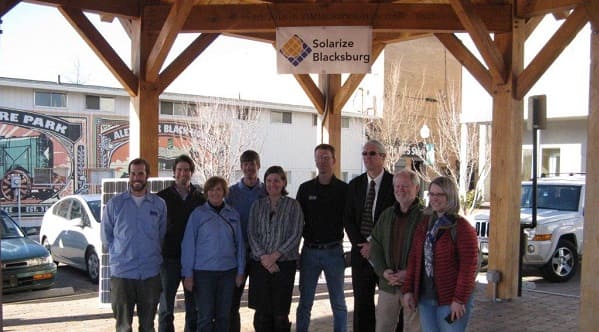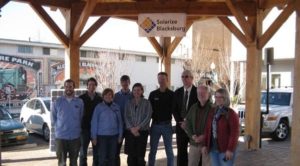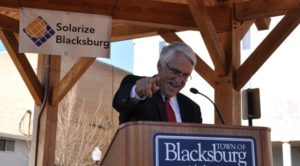How solar group purchases got their start in Virginia


The Greater Roanoke Solar Co-op is the first time that Solar United Neighbors has returned to southwest Virginia since we partnered with the Town of Blacksburg for the Solarize Blacksburg and Solarize Montgomery programs in 2014. The program was the first of its kind in Virginia and laid the groundwork for successful solar group purchases in the state. If you’re in the Greater Roanoke area, you can still sign up for the Greater Roanoke Solar Co-op before the July 2 deadline!
We interviewed Carol Davis, Sustainability Manager for the Town of Blacksburg and one of the founders of Solarize Blacksburg, to get her perspective on how solar group purchases got their start in Virginia.
How did the Solarize Blacksburg program get started?
The Solarize Blacksburg program emerged from the New River Valley Livability Initiative’s three-year regional energy planning process which concluded in early 2014, which produced “Energy In the New River Valley: Creating an Affordable, Reliable, and Sustainable Energy Future,” a long-range plan for our region’s clean energy future. One of the priority strategies in the plan was to “Explore a pilot community “Solarize” type program to generate interest for bulk pricing of solar energy installations at the neighborhood/community scale.”
I was one of five members from the Livability Initiative’s Energy Working Group who came together to accelerate implementation of this particular strategy. The others included Mason Cavell, Community Program Manager for Community Housing Partners Energy Solutions Center; Beth Lohman, a local solar homeowner and solar policy advocate; John Randolph, an urban planning professor at Virginia Tech with a specialization in renewable energy; and Pat Bixler, owner of a local renewable energy firm.
Although we represented the core of the planning team, numerous other members of the Blacksburg community supported the planning and execution of the first Solarize program, which was formally launched in March of 2014.
What lead you to partner with Solar United Neighbors?
Mason Cavell brought Solar United Neighbors (then known as Virginia SUN, a program of Community Power Network) to the table when he learned of the organization’s work with bulk purchase programs in the Washington, D.C. area. VA SUN was eager to work with Blacksburg on building the new program and helping to provide administrative and technical support.
What were some of the challenges you encountered?
Being the first Virginia program posed many challenges, largely because we were figuring it out as we went along (see some of our lessons learned below). While there were several hiccups along the way, the program actually went very smoothly once it was up and running.
What did you learn from the experience?
We all learned a lot about what is needed to craft, launch, and run a successful bulk purchase program. A few of the concrete lessons include:
- Get community leaders and trusted advocates on board as cheerleaders for your program. At a minimum, make sure all your elected officials are aware of the program before it launches!
- Have a plan and (legally-defensible) guidance documents for working with recalcitrant homeowners’ associations.
- If possible, make a solar payback calculator available—and make sure that the tool is available online. It’s a very valuable outreach tool.
- If you’re running a Solarize type program, make sure your installers fully understand what they’re signing on for, including: project administration and the responsibility to be responsive and communicative with their leads (otherwise you will get LOTS of calls from program participants!).
- Connecting energy efficiency and solar together is worthwhile, but a difficult sell during the process of going solar. Consider working with a local energy efficiency firm to offer low- or no-cost home energy evaluations as a part of the program or the possibility of integrating the value of energy efficiency + solar post- installation.
- Try to do some up-front work with your locality’s planning department on zoning issues, particularly with regard to ground-mounts and solar within historic districts.
- Work with your building official to develop a roof structural checklist to help defray unnecessary engineering expenses and potential delays for your participants.
- Working with a local lender for the duration of the project can be helpful for securing favorable financing for the program participants.
- Be sure that your engagement and outreach plan includes traditional media, social media, community flyering, and a whole bunch of community meetings.
What did Solarize Blacksburg bring to the community?

It fundamentally changed the solar energy landscape of our community—and in Virginia. There is hardly a street in Blacksburg that doesn’t have a solar roof on it now, and some neighborhoods have been utterly transformed. In less than 6 months, we more than quadrupled the amount of solar—resulting in more than a million dollars of clean energy investments within the community. In Virginia, bulk purchases run by Solar United Neighbors of Virginia and other organizations have resulted in more than 1,000 individual installations accounting for approximately ¼ of all residential solar installations in the state since 2014.
It also really put Blacksburg on the map—both within Virginia as a solar leader and on the national stage. We received the U.S. Conference of Mayors Climate Protection Award for 2015 as a result of our efforts in Blacksburg and across the state.
Did you expect Solarize Blacksburg to have such a large impact?
Absolutely not.
We were keenly aware of the challenging energy policy environment within Virginia. We also knew that Solarize type programs had only been attempted in states with an “A” or “B” rating for residential solar polices. At the time of the Solarize Blacksburg launch, I believe Virginia had a “D” rating. Retail net metering was pretty much the only thing on our side—that and the federal tax credit. We genuinely did not know if it would be a total flop.
I recall that just prior to the launch event, a member of the planning team asked if we ought to set a program goal. We decided to shoot for the moon and name an outrageously impossible goal—to double the amount of installed solar capacity in the town. Well, within an hour of the launch, we had more than 70 signups. By the close of the subsequent Solarize Montgomery program the following year, we had helped nearly 100 households go solar. Many of these folks have become huge solar evangelists and advocates ever since!
Where do you see group purchase programs going in Virginia moving forward?
This is a key question that many communities who have hosted Solarize or Solar Co-op programs are grappling with. In fact, it was a major topic of conversation at the most recent Virginia Energy & Sustainability Peer Network Peer Learning Exchange.
We want to build a market for solar that balances the desire to drive down prices for homeowners while enabling solar installers to maintain profitability and offer good-paying jobs to their staff. Many of us also have concern about creating boom and bust cycles of solar interest, which is tricky for solar installers to navigate, having to ramp their staffing up and down as needed. For now, it’s an issue many of us have recognized, but don’t yet have any easy or obvious solutions. One of the advantages, especially with the Solar Co-op model, is that it builds a base of advocacy that to fight for solar policies in Virginia benefiting the industry as a whole.
